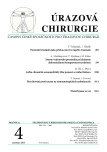Treatment of chronic tibial osteomyelitis with external fixator
Authors:
Milan Šír; Leopold Pleva
Authors‘ workplace:
Traumatologické centrum FN Ostrava, Ústav medicíny katastrof LF Univerzity Ostrava
Published in:
Úraz chir. 21., 2013, č.4
Overview
AIM:
The aim of the presented study was to assess the results of treatment of tibial osteomyelitis with external fixator, to compare the outcomes with other centres, and to propose a solution for improvement.
MATERIALS AND METHODS:
A total of 28 patients with tibial osteomyelitis were treated at the Traumatology Centre of the University Hospital Ostrava between 2000 and 2006. All patients underwent a complex treatment, where the decisive role is played by the remediation of the skeletal infection and treatment of the resulting bone defect. The skeletal stabilization was performed exclusively with external fixators. We evaluated the treatment results at two years after the completion of the treatment according to the ASAMI criteria. We assessed the results of bone healing, together with functional assessment, the number of necessary amputations and return of the patients to their original employment.
RESULTS:
We obtained results classified as “excellent” and “good” in more than 80 % of the patients. Consequently, we compared the observed results with other centres in the world dealing with this topic. It is possible to conclude, that our results were comparable. Nevertheless, the treatment period in these patients is very long and many patients suffer from permanent consequences of the injury, such as decreased mobility in the malleolar joint, limping and the necessity to use crutches.
CONCLUSION:
A complex treatment of osteomyelitis is a necessary precondition for successful treatment outcomes. Possible means of improving the results include an early debridement and the use of a suitable method of treatment of the bone defect, more active cooperation with specialists in the plastic surgery in performing a quality coverage of the sustained defects of soft tissues, necessary for healing of the skeleton, and a close cooperation with physiotherapists during an active and early rehabilitation treatment aimed at the quality of mobility of the malleolar joint and training of a correct gait stereotypes. This procedure will result in shortening of the treatment period and decreasing the extent of permanent consequences. An integral part of the treatment success is to teach the patient how to manipulate with the external fixator in such a way as to establish a “friendly relationship” between the patient and his external fixator.
Keywords:
chronic tibial osteomyelitis, external fixator, complex treatment.
Sources
1. WALDVOGEL, F., MEDOFF, G., SWARTZ, M. Osteomyelitis: a review of clinical features, therapeutic considerations and unusual aspects (I). N Engl J Med. 1970, 282, 198–206.
2. PARSONS, B., STRAUSS, E. Surgical management of chronic osteomyelitis. Am J Surg. 2004, 188, 57S–66S.
3. STEMBERGER, A., GRIMM, H., BADER, F. et al. Local treatment of bone and soft tissue infections with the collagen-gentamicin sponge. Eur J Surg. 1997, Suppl 578, 17–26.
4. HESSMANN, M., ROMMENS, P.M., HAINSON, K. Callus distraction of the femur and tibia. Experience with the Monofixator – indications for reosteosynthesis. Unfallchirurg. 1998, 5, 370–376.
5. HOFMANN, GO., GONSCHOREK, O., BÜHREN, V. et al. Segment transport employing intramedullary decides in tibial bone defects following trauma and infection. J Orthop Trauma. 1999, 13, 3, 170–177.
6. DENDRINNOS, GK. et al. Use of the Ilizarov technique for treatment of non-union of the tibia associated with infection. J Bone Joint Surg Am. 1995, 77, 635–646.
7. PATIL, S., MONTGOMERY, R. Management of complex tibial and femoral nonunion using the Ilizarov technique, and its cost implications. J Bone Joint Surg. 2006, 88-B, 3, 928–932.
8. MAINI, L., CHADHA, M., VISHWANATH, J. et al. The Ilizarov method in infected nonunion of gractures. Injury. 2000, 31, 509–517.
Labels
Surgery Traumatology Trauma surgeryArticle was published in
Trauma Surgery

2013 Issue 4
- Metamizole vs. Tramadol in Postoperative Analgesia
- Metamizole at a Glance and in Practice – Effective Non-Opioid Analgesic for All Ages
- Possibilities of Using Metamizole in the Treatment of Acute Primary Headaches
- Current Insights into the Antispasmodic and Analgesic Effects of Metamizole on the Gastrointestinal Tract
- Spasmolytic Effect of Metamizole
Most read in this issue
- Metabolic and biochemical changes in acute abdominal compartment syndrome
- Revaccination against tetanus at traumatology outpatient clinic
- Thoracic trauma as cause of the death in blunt injuries
- Treatment of chronic tibial osteomyelitis with external fixator
